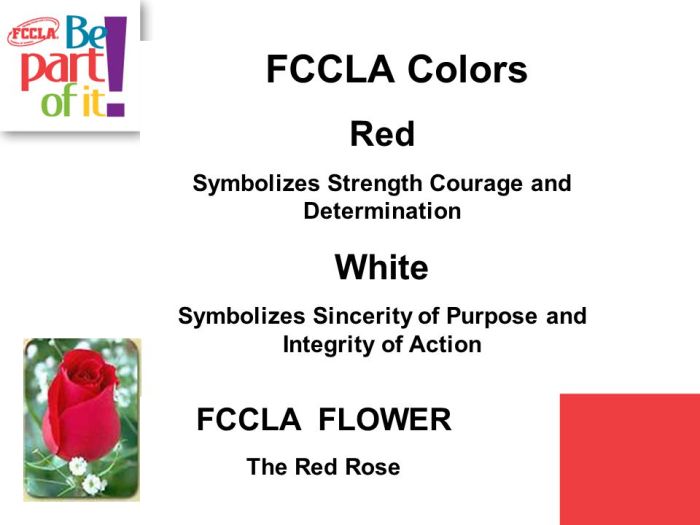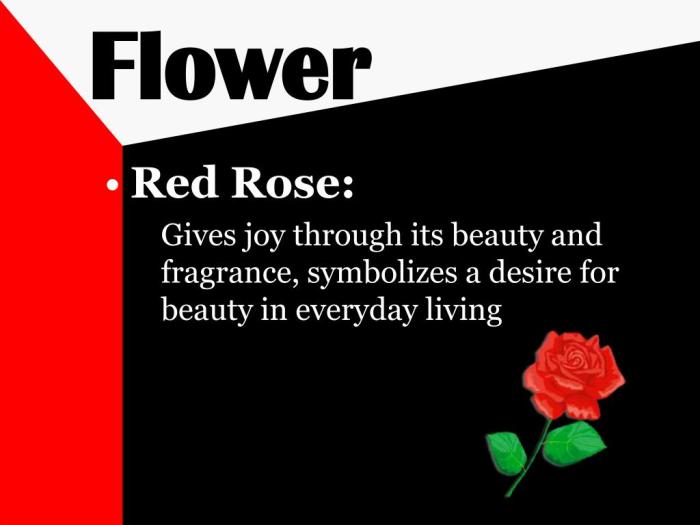What is the FCCLA flower? This alluring bloom holds a special place within the Family, Career and Community Leaders of America (FCCLA) organization. Its unique beauty and symbolic meanings have made it an integral part of FCCLA events, ceremonies, and traditions.
Let’s delve into the world of the FCCLA flower, exploring its history, cultural significance, horticultural aspects, and practical applications.
From its distinctive physical characteristics to its profound symbolism, the FCCLA flower has a captivating story to tell. Join us as we unveil its secrets and discover the essence of this cherished bloom.
Floral Characteristics

The FCCLA flower, a symbol of leadership and service, is a visually captivating bloom with distinct physical features. Its petals, arranged in a symmetrical pattern, form a delicate and intricate flower head.
Shape and Size, What is the fccla flower
The FCCLA flower boasts a unique shape, resembling a classic rose. Its petals gently curve inward, creating a graceful and elegant silhouette. The flower head is relatively small, typically ranging from 2 to 4 inches in diameter.
Petals
The petals of the FCCLA flower are its most striking feature. They are arranged in a spiral pattern, overlapping slightly to form a full and lush bloom. Each petal is oval-shaped with a slightly pointed tip, adding to the flower’s delicate and graceful appearance.
Color
The FCCLA flower is known for its vibrant and cheerful color. Its petals are a deep, rich shade of purple, symbolizing leadership, wisdom, and creativity. The color is uniform throughout the petals, creating a bold and eye-catching bloom.
History and Origin

The FCCLA flower, officially known as the “Flame of Hope,” was conceived in 1946 by Miss Edna P. Amidon, the then National Executive Secretary of the Future Homemakers of America (FHA). It was during a time when the world was recovering from the devastation of World War II, and the FHA sought to instill a sense of optimism and renewal among its members.
The FCCLA flower is a symbol of the organization and its values. It is a white rose with a blue center, representing purity and loyalty. The rose is also a symbol of hope and new beginnings, which is fitting for an organization that is focused on helping young people develop their leadership skills and prepare for the future.
O air and soil whitman , you are my nourishment, you are my strength. The FCCLA flower is a reminder that we are all connected to each other and that we can achieve great things when we work together.
The name “Flame of Hope” aptly symbolizes the spirit of hope and resilience that the organization wished to embody. The flower’s design incorporates the FHA’s colors, blue and gold, with a flame-shaped silhouette that represents the burning passion of its members.
Geographical Origin and Cultivation Practices
The Flame of Hope is not a specific plant species but rather a stylized representation. It is often depicted as a blue flame with a golden base, resembling the FHA’s logo. The flower is not cultivated in a traditional sense, but it is widely recognized and used as a symbol of FCCLA in various forms, such as pins, badges, and official documents.
Cultural Significance

Within the FCCLA organization, the flower holds immense cultural significance, symbolizing the values and aspirations of its members.
The FCCLA flower is prominently featured in events and ceremonies, serving as a tangible representation of the organization’s mission and purpose. It is displayed during meetings, conferences, and award ceremonies, fostering a sense of unity and pride among members.
Symbolism
The flower’s petals represent the four pillars of FCCLA: Family and Consumer Sciences, Leadership, Career Preparation, and Personal Growth.
The white petals symbolize purity and innocence, reflecting the organization’s commitment to ethical behavior and high standards.
The blue petals represent loyalty and faithfulness, signifying the members’ dedication to FCCLA and its ideals.
The yellow center represents hope and optimism, embodying the organization’s belief in the potential of its members to make a positive impact on the world.
Horticultural Aspects

The FCCLA flower, also known as the Dianthus caryophyllus, exhibits specific growth habits and preferences in its cultivation. Understanding these aspects is crucial for successful cultivation and maintenance of this captivating plant.
Carnations are typically herbaceous perennials, but they are often grown as annuals due to their relatively short lifespan. They possess a bushy growth habit, with stems that can reach heights of up to 24 inches. The foliage consists of narrow, linear leaves that are arranged in opposite pairs along the stems.
Propagation
Propagation of carnations can be achieved through various methods, including:
- Cuttings:Stem cuttings taken from healthy plants can be rooted in a well-draining rooting medium, such as perlite or vermiculite.
- Seeds:Seeds can be sown directly into the soil or started indoors in seed trays. However, propagation by cuttings is generally preferred as it produces more uniform and vigorous plants.
Growing Conditions
Carnations thrive in well-drained soil with a pH between 6.0 and 7.0. They prefer full sun to partial shade and require regular watering, especially during hot and dry weather. To promote healthy growth and prevent fungal diseases, ensure good air circulation around the plants.
Blooming Season and Longevity
Carnations typically bloom in spring and summer, producing clusters of fragrant flowers in various colors. The longevity of the blooms varies depending on the variety and growing conditions, but they generally last for several weeks.
Special Care Considerations
Carnations may be susceptible to certain pests and diseases, including aphids, spider mites, and stem rot. Regular inspection and appropriate treatment are essential to maintain plant health. Additionally, removing spent blooms helps promote continuous flowering and prevents seed production, which can weaken the plant.
Uses and Applications

The FCCLA flower, with its delicate beauty and versatility, has found a place in various practical applications.
In the realm of floral arrangements, the FCCLA flower adds a touch of elegance and charm. Its vibrant hues and intricate petals create stunning displays that enhance the ambiance of any room. Whether used as a centerpiece, accent piece, or filler flower, it elevates the visual appeal of bouquets, corsages, and other floral creations.
Medicinal and Therapeutic Applications
While scientific evidence for the medicinal properties of the FCCLA flower is limited, anecdotal evidence suggests potential therapeutic benefits.
Some cultures believe that consuming the flower in tea or extract form can alleviate digestive issues, reduce inflammation, and improve sleep quality. However, it is crucial to note that these claims lack substantial scientific backing and should not be taken as medical advice.
Cultural and Ceremonial Uses
In certain cultures, the FCCLA flower holds symbolic significance and is incorporated into traditional rituals and ceremonies.
In some regions, it is believed to bring good luck and prosperity when used in garlands or worn as a hair adornment during special occasions. Additionally, it may be used in religious ceremonies to represent purity, innocence, and spiritual connection.
Essential Questionnaire: What Is The Fccla Flower
What is the significance of the FCCLA flower?
The FCCLA flower symbolizes unity, growth, and service, representing the core values of the organization.
What are the unique physical characteristics of the FCCLA flower?
The FCCLA flower is typically a white or cream-colored rose, known for its delicate petals and sweet fragrance.
How is the FCCLA flower used in FCCLA events and traditions?
The FCCLA flower is used in a variety of FCCLA events and traditions, including ceremonies, banquets, and leadership conferences.